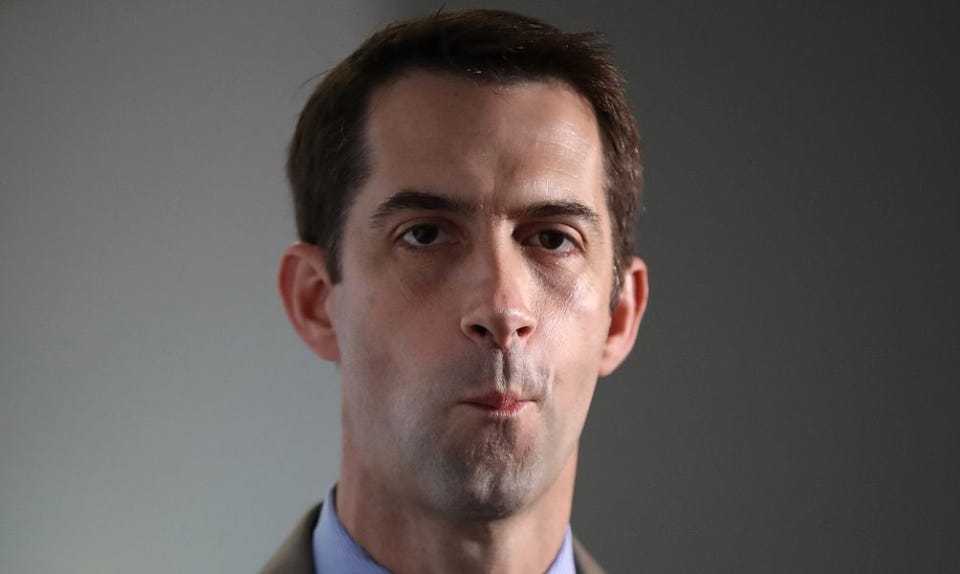This afternoon, Senator Tom Cotton — whom you might remember from his previous principled stances like “drivers should simply assault left-wing protesters,” “the military should simply attack left-wing protesters” and “right-wing protesters may have assaulted cops but they’re the *real* victims here” — has offered more of the kind of high-minded wisdom we’d expect from such a statesman, urging that the National Guard be sent in to stop a peaceful student protest about divestment or, as he calls it, “a nascent pogrom.”
While it’s true to form for Sen. Cotton to display his bloodlust when it comes to left-wing protesters, this latest call for a clampdown is even more disturbing than some of the others, given its obvious echoes of the National Guard’s deployment to college campuses 54 years ago and the deadly, disastrous results of that decision.
So, I thought I’d send out a brief refresher on that:
In April 1970, President Richard Nixon announced that the U.S. government had greatly expanded the War in Vietnam to include first the massive bombing and then a full-scale ground invasion of neighboring Laos, which had provided cover for the Viet Cong guerillas.
An immediate result of Nixon's announcement was a huge outburst of antiwar demonstrations across the country.
The night after the speech, students at Kent State University in Ohio flung bottles at police cars and smashed store windows. The night after that, someone fire-bombed the university's ROTC building.
The next day, Governor James Rhodes of Ohio traveled to Kent State and gave a stern speech which echoed much of the administration's rhetoric on crime. "We are not going to treat the symptoms," he said. "We are going to eradicate the problem." He said that a small group, numbering "three or four" was responsible for "the most vicious form of campus-oriented violence" in Ohio. Pounding on a table, Rhodes yelled that "They're worse than the Brown Shirts and the Communist element and also the night riders and the vigilantes. They're the worst type of people we harbor in America."
When Kent State had a new round of protests, Governor Rhodes acted upon his words and mobilized the National Guard. On May 4, 1970, some 500 protestors faced off against the guardsmen, throwing rocks at them, and being blasted with tear gas in return. Although the closest demonstrators were 60 feet away, some of the guardsmen opened fire on them, wounding nine and killing four.
Importantly, none of the four killed were armed; two of them had been totally uninvolved in the protests and were simply walking to class.
In a similar incident a few days later at Jackson State University in Mississippi, two other students were killed in another shooting, and eleven more were wounded.
And once again, the two students who were killed were not part of the protest.
The National Guard had been brought to these campuses because of the supposed threat of student activism. They were supposedly there to protect all the “innocent” students from the danger posed by those protests, but they wound up killing six of those same innocent students.
News of the Kent State and Jackson State shootings inflamed college campuses across the country. Campuses that had until then experienced little antiwar activity were suddenly convulsed in violence.
Student strikes that May affected some 350 colleges, and estimates put the number of students involved in the demonstrations at around 2 million, which was 25% of the university students in America, by far a record high. Thirty ROTC buildings were burned or bombed.
The National Guard had to be called out in 16 states and on 21 campuses, but again, their mobilization only inflamed the situation and made things worse. More than 75 colleges and universities decided to close down for the remainder of the academic year, and the antiwar movement became much stronger too.
In the end, the deployment of the National Guard failed in every way. It didn’t keep the students on these campuses safe, and it didn’t curtail criticism of the Nixon administration’s foreign policy. It was simply a knee-jerk overreaction that made short-sighted, small-minded, weak-willed right-wing men feel better about themselves for a moment.
Which, of course, is why Tom Cotton is calling for a repeat now.








Born 1962, in Cincinnati, Ohio. Mom was infuriated about what happened at Kent State . Made sure we knew the truth, even though we were children. Here’s your background music for this excellent piece. “Four Dead in Ohio”. https://www.youtube.com/watch?v=JCS-g3HwXdc
I'd heard about Kent State, but I don't recall learning about Jackson State.